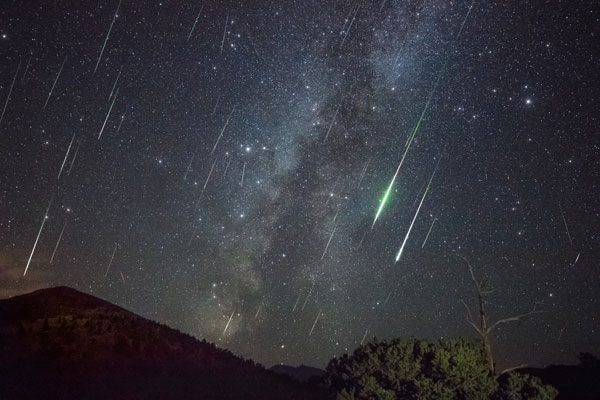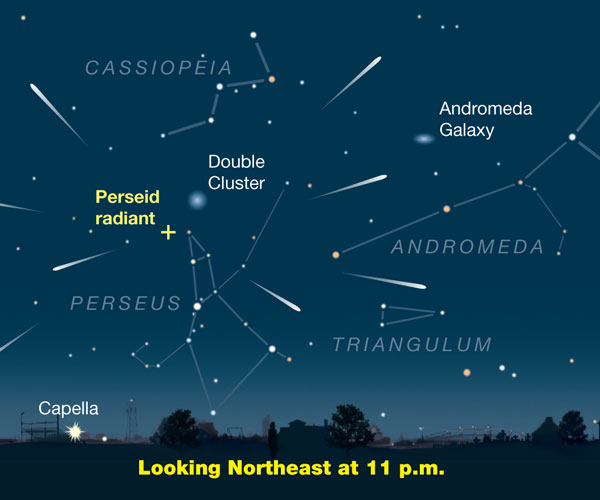Plan for optimal conditions for this year’s Perseid meteor shower early in the mornings of August 12th and 13th.

Jeremy Perez
“Stars fell like weaving in the south, unceasingly through the night.” So a city gazetteer printed in Shanxi, China, described the sky above Fenyang on August 10, 1862. Calculating backward, scholars have determined that the “weaving stars” witnessed by the townspeople were in fact Perseid meteors, falling at a time when the shower’s radiant, the point from which the meteors appear to emanate, lay low in the sky.
The Perseids are associated with the short-period Halley-type comet 109P/Swift-Tuttle, which was independently discovered by American astronomers Lewis Swift and Horace Tuttle as it approached perihelion in July 1862. When Earth crosses Swift-Tuttle’s orbit, bits of dust and rocks left behind by the comet hit the planet’s atmosphere, creating the light show we know as the Perseid meteor shower. In years when Swift-Tuttle reaches perihelion, the number of visible meteors significantly increases, which explains the dramatic display of August 1862. Since the comet has a 133-year orbital period and last visited the inner solar system in 1992, we’ve got another 107 years to go before that possibility arises again. Occasional bump-ups in the number of detected meteors do occur when Earth passes close to dust trails left behind during even earlier visits. However, the next such major outburst isn’t predicted until 2028. Even so, the “ordinary” Perseids make for a strong shower and an impressive spectacle. Under ideal, dark skies, viewers may see more than 50 meteors in an hour.
The extant Chinese records for the 1862 event all come from northern China, suggesting unfavorable weather in the south that year. Here and now in 2018, we hope for good weather for the summer’s greatest shower, because viewing conditions should otherwise be perfect. The shower’s predicted peak falls on the evening of August 12th, soon after new Moon (9:58 UT August 11th). Weather and light pollution (and possibly mosquitoes) should be the only impediments to a good show. The best viewing will certainly be early on the mornings of August 12th and 13th, but don’t wait for the predicted peak to go outside. Perseids begin streaking across the sky in mid-July, when the radiant is still in Cassiopeia, and the odd shower meteor will continue to be visible until around August 24th.

The easiest way to view a meteor shower is to kick back with a lawn chair and a sleeping bag. All you really need to do to see the show is look up, stay warm, and stay awake. Find the darkest sky you can, away from street lights. For most viewers in the Northern Hemisphere, shower meteors can appear any time after evening twilight ends, since the radiant in Perseus is circumpolar (i.e., up all night). So start looking as soon as evening twilight ends. These early evening space streaks will be long, showy “Earthgrazers” that skim Earth’s upper atmosphere. As the radiant moves higher in the northeast throughout the evening, the meteors will become more frequent and appear all over the sky. The later you observe, the more meteors you’ll see, and the best hours fall between midnight and dawn.
The most suitable equipment for watching a meteor shower are desire and dark skies, but if you’d like to document your observations more formally, the International Meteor Organization (IMO) recommends that visual observers track sky activity for at least 1 hour, with reports broken into short intervals of no longer than 15 minutes. For more detailed instructions regarding recording and reporting, visit the IMO Visual Observations page. Earth may encounter a Perseid filament — a relatively young accumulation of meteoroids — on August 12th around 20h UT. There’s also a possibility of our planet meeting an old Swift-Tuttle dust trail on August 13th around 1h 27m UT. Accurate observation records may help detect activity connected to filament and meteoroid clump.
This article originally appeared in print in Sky & Telescope's August 2018 issue.
 5
5









Comments
Rod
August 11, 2018 at 10:33 am
I did observe a few Perseids early Friday morning on 10-Aug. One flashed by Capella in Auriga about as bright as the star too. This was 0430-0500 EDT, Perseus radiant up about 63 degrees altitude and 54 degrees azimuth for my location in Maryland. Thursday night, 09-Aug, I enjoyed some telescope views of Jupiter, Saturn,and Mars while also looking for Perseids - did not see any but enjoyed the views of the planets. It looks like more rain and possible t-storms as well as heavy cloud coverage where I am at for the weekend.
You must be logged in to post a comment.
and3rd62
August 13, 2018 at 1:39 pm
I saw two or three good Perseids over the course of the past few days. Overall, it wasn't anything to write home about. Friday night (08/11) looking north, saw a nice bright slow-moving meteor swooping down from overhead at 2210 EDT. Clouds moved in not long afterwards. Had clouds and light rain on Saturday night/Sunday morning. Best one was Monday morning at 0441 hours, saw a large bright one shooting down from Perseus to the NW, flamed out with a nice smoke trail. Saw several much smaller fast ones after that shooting towards the SW from Perseus. Had to hit the hay at 0500 hours. Viewing location was Putney, GA (south Dougherty County)
You must be logged in to post a comment.
Rod
August 13, 2018 at 10:33 pm
That is good and3rd62. I did not see any early this morning along the Patuxent River valley farms where I am at in Maryland - clouds and light rain. However, some folks I know were in Gettysburg PA did see some - "we saw seven in about a half hour from 1:15-1:45 AM before the clouds rolled in!" I enjoyed viewing a few more Perseids too on 12-Aug, "Observed 0500-0530 EDT. USNO sunrise at 0618 EDT, begin civil twilight at 0549 EDT. I did observe some Perseids this morning while sitting in the chair by backdoor on the sidewalk. 2 or 3 were about mv + 2.0 and one bright Perseid flashed by Aldebaran in Taurus, about mv +0. This was fun early Sunday morning to watch. The sky started brightening up near 0530 EDT as civil twilight approached."
You must be logged in to post a comment.
JRPost Author
August 14, 2018 at 9:58 am
Excellent reports. We had smoky conditions from the forest fires raging in Washington and British Columbia, so it was "catch as catch can" for the Perseids. We had a few good ones in evening before the peak -- and a brilliant bolide erratic two nights before -- but the actual peak night was smoked out.
You must be logged in to post a comment.
George Gliba
August 14, 2018 at 2:13 pm
t looks like the Perseid peak occurred a bit later than predicted on the 13th. I was observing
last evening before midnight from 9:50 to 10:50 PM (01:50 to 02:50 UT Aug. 14th) and saw
several beautiful grazers. I was out earlier than planned because it was clear and I was hoping
to see a couple of Earth Grazers. Well, to my surprise there were several nice ones. Also, the
rates seemed higher than expected. Unfortunately the clouds were a nuisance, but at least it
stayed mostly clear until about 11:20 PM when it became very cloudy.
You must be logged in to post a comment.
You must be logged in to post a comment.